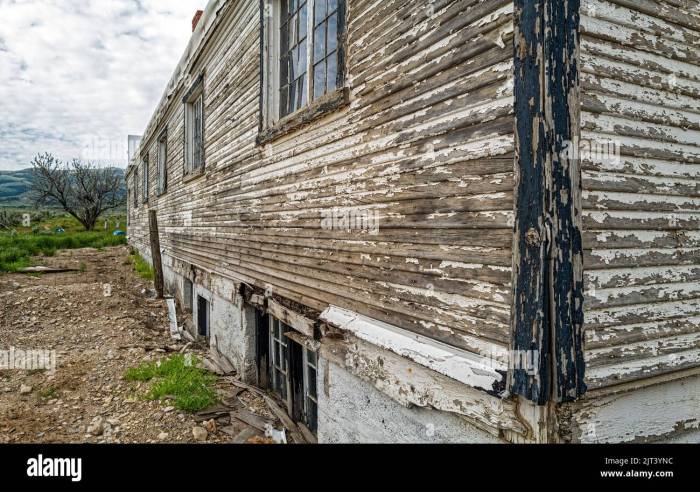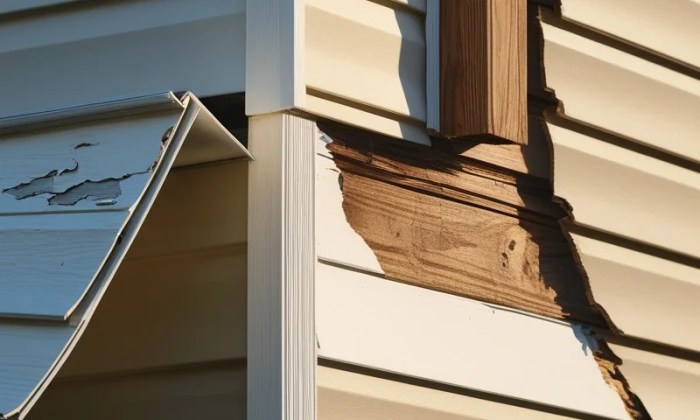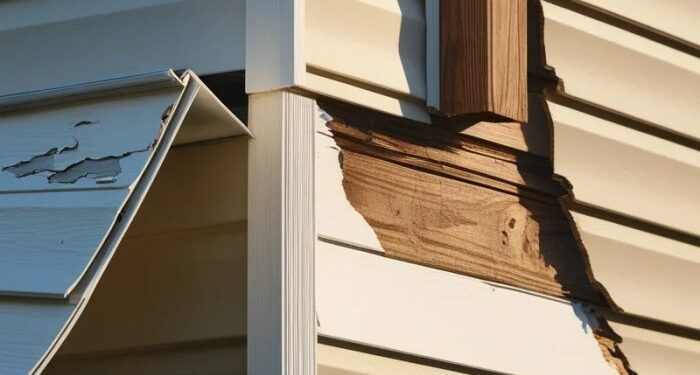Exploring the common issue of siding falling off houses, this article delves into the reasons, types of siding materials, inspection, maintenance, and repair techniques. With a mix of informative content and practical tips, readers will gain a deeper understanding of this problem and how to address it effectively.
Types of Siding
When it comes to choosing siding for your house, there are several common materials to consider. Each type of siding has its own set of pros and cons that can impact the overall durability and maintenance needs of your home.
Vinyl Siding
Vinyl siding is a popular choice for its affordability and low maintenance. It is available in a wide range of colors and styles, making it versatile for different home designs. However, vinyl siding can crack or fade over time, and it may not be as durable as other materials.
Wood Siding
Wood siding offers a classic, natural look that many homeowners love. It can be painted or stained in various colors to suit your preferences. While wood siding is durable and can last for a long time with proper maintenance, it is susceptible to rot, pests, and moisture damage.
Fiber Cement Siding
Fiber cement siding is a durable and low-maintenance option that can mimic the look of wood or stucco. It is resistant to fire, insects, and rot, making it a long-lasting choice for many homeowners. However, fiber cement siding can be more expensive than other materials and may require professional installation.
Aluminum Siding
Aluminum siding is lightweight, easy to install, and resistant to rust and rot. It can be painted in different colors and is relatively low maintenance. On the downside, aluminum siding can dent easily and may not offer as much insulation as other materials.
Brick Siding
Brick siding is known for its durability and timeless appeal. It can withstand harsh weather conditions and requires minimal maintenance. However, brick siding can be costly to install and repair, and it may not be as energy-efficient as other materials.
Stone Veneer Siding
Stone veneer siding provides a luxurious and upscale look to any home. It is durable, fire-resistant, and requires little maintenance. However, stone veneer siding can be expensive to install and may not be as weather-resistant as other materials.
Reasons for Siding Falling Off
When it comes to siding falling off a house, there are several common reasons that can contribute to this issue. Factors such as weather conditions and poor installation can significantly impact the stability of siding, leading to detachment from the house.
Impact of Weather Conditions
Weather conditions play a crucial role in the integrity of siding on a house. Exposure to extreme temperatures, moisture, and strong winds can weaken the siding material over time. For instance, prolonged exposure to sunlight can cause the siding to fade, become brittle, and eventually crack.
On the other hand, heavy rain or snow can seep into the siding, causing it to swell and warp. Additionally, high winds can put pressure on the siding, leading to loosening and detachment.
Role of Poor Installation
Another significant factor that can cause siding to fall off is poor installation. When siding is not properly installed, it is more susceptible to damage and detachment. Improperly secured siding or using incorrect installation techniques can result in gaps, loose panels, or inadequate support, making it easier for the siding to come off.
Inadequate fastening or using the wrong type of fasteners can also contribute to the siding detaching from the house.
Inspection and Maintenance

Inspecting your siding regularly is crucial to detect any signs of damage or detachment early on. This can help prevent siding from falling off and avoid costly repairs in the future. Maintaining your siding is equally important to ensure its longevity and structural integrity.
Step-by-Step Guide for Inspecting Siding
- Start by visually inspecting the exterior of your home for any visible damage to the siding, such as cracks, holes, or warping.
- Check for any areas where the siding may be loose or coming off the wall.
- Inspect the corners and edges of the siding for signs of wear and tear.
- Look for any signs of mold, mildew, or moisture damage on the siding panels.
- If possible, gently press on the siding to check for any soft spots or areas of weakness.
Tips for Maintaining Siding
- Regularly clean your siding with a mild detergent and water to remove dirt, debris, and mold buildup.
- Trim any vegetation or trees near the siding to prevent damage from branches or roots.
- Repaint or reseal your siding every few years to protect it from the elements and maintain its appearance.
- Repair any damaged or loose siding promptly to prevent further deterioration.
- Consider hiring a professional for a thorough inspection and maintenance of your siding at least once a year.
Importance of Regular Inspections and Maintenance
Regular inspections and maintenance play a vital role in preserving the integrity of your siding. By addressing issues early on and taking preventive measures, you can prolong the lifespan of your siding and ensure the safety and aesthetics of your home.
Ignoring maintenance can lead to more significant damage and costly repairs down the line.
Repairing Detached Siding

When siding falls off a house, it is essential to address the issue promptly to prevent further damage and maintain the integrity of the home. Repairing detached siding can be a DIY project for those with some basic tools and skills, but it may also require professional help depending on the extent of the damage.
Process of Repairing Detached Siding
Repairing detached siding typically involves the following steps:
- Clean the area: Remove any debris or loose pieces of siding around the damaged area.
- Assess the damage: Determine the cause of the detachment and evaluate the extent of the damage.
- Secure the siding: Use nails or screws to reattach the siding to the house securely.
- Seal the edges: Apply caulk or sealant to the edges of the siding to prevent water infiltration.
- Paint or touch up: If necessary, repaint or touch up the repaired area to match the rest of the siding.
Tools and Materials Needed for DIY Siding Repair
To repair detached siding as a DIY project, you will need the following tools and materials:
- Hammer or screwdriver
- Nails or screws
- Caulk or sealant
- Paint and brush
- Ladder
- Siding pieces (if replacement is necessary)
Cost Comparison: DIY vs. Professional Repair
Repairing detached siding as a DIY project can be cost-effective if you already have the tools and materials needed. However, hiring a professional may ensure a more secure and long-lasting repair, especially for extensive damage. The cost of DIY repairs will vary depending on the materials needed, while professional repairs may involve labor costs in addition to materials.
It is essential to weigh the pros and cons of each option based on the specific situation and budget.
Final Thoughts
In conclusion, understanding the causes of siding falling off houses and knowing how to inspect, maintain, and repair it is crucial for homeowners. By following the guidelines Artikeld in this article, you can ensure the longevity and structural integrity of your home's siding.
FAQ Section
Why does siding fall off houses?
Siding can fall off due to factors like poor installation, weather conditions, or age-related deterioration.
How can homeowners prevent siding from falling off?
Regular inspections, timely maintenance, and addressing issues promptly can help prevent siding from falling off.
Is DIY siding repair cost-effective?
DIY siding repair can be cost-effective if you have the necessary tools and skills; otherwise, hiring a professional might be a better option.














